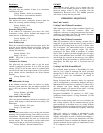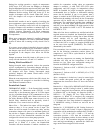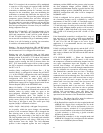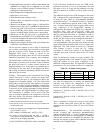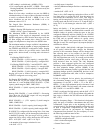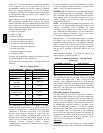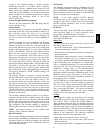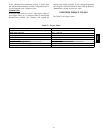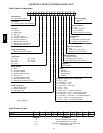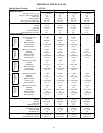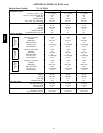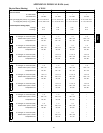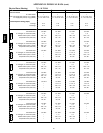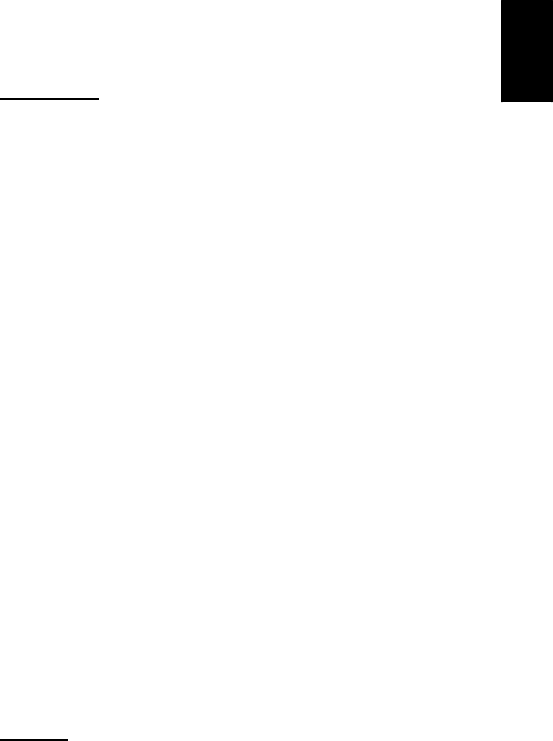
79
control to the occupied heating or cooling setpoints.
Scheduling functions are located under occupancy
determination and the schedule menu accessed by the
Menu softkey (see Appendix -- for menu structure). Your
local time and date should be set for these functions to
operate properly. Five scheduling functions are available
by changing the Occupancy Source to one of the
following selections:
Always Occupied (Default Occupancy)
The unit will run continuously. RTU--MP ships from the
factory with this setting.
Local Schedule
The unit will operate according to the schedule configured
and stored in the unit. The local schedule is made up of
three hierarchy levels that consist of two Override
schedules, twelve Holiday and four Daily schedules, and
are only accessible by the BACview screen (handheld or
virtual).
The Daily schedule is the lowest schedule in the hierarchy
and is overridden by both the Holiday and Override
schedule. It consists of a start time, a stop time (both in 24
hour mode) and the seven days of the week, starting with
Monday and ending in Sunday. To select a daily schedule
scroll to the Schedules menu off of the Menu selection.
Enter the User password and change the Occupancy
Source to Local Schedule. Scroll down and over to the
Daily menu and press enter. Choose one of the four Daily
schedules by pressing the Next softkey and change the
Use? point from NO to YES by selecting the point and
pressing the INCR or DECR softkey. Press the OK softkey
and scroll to the start and stop times. Edit these times
following the same steps as the Use? point. Finally scroll
down to the Days: section and highlight the days required
for the Daily schedule by INCR or DECR softkeys and
press OK softkey.
The Holiday schedule is created to override the Daily
schedule and identify a specific day and month of the year
to start and stop the unit and change control to the
unoccupied heating and cooling setpoints. Follow the
same steps to turn on one of the twelve Holiday schedules
and start and stop times. Next, select one out of the twelve
months and one out of the thirty--one days of that month.
The RTU--MP will now ignore the Daily schedule for the
specific day and time you selected and follow the Holiday
Schedule for this period.
The Override schedules primary purpose is to provide a
temporary change in the occupied heating and cooling
setpoints and force the unit to control to the unoccupied
heating and cooling setpoints. This would occur on a set
day in a particular month and last during the start and stop
time configured. The Override schedule is enabled by
following the same steps to create the Holiday schedule.
NOTE: Push button override is only available when
running a local or BACnet Schedule.
BACnet Schedule
For use with a Building Automation System that supports
native BACnet scheduling is scheduling the unit. With the
Occupancy Source set to BACnet schedule the BAS will
control the unit through network communication and it’s
own scheduling function.
BAS On/Off
The Building Automation System is scheduling the unit
via an On/Off command to the BAS ON/OFF software
point. The Building Automation System can be speaking
BACnet, Modbus, or N2 and is writing to the BAS On/Off
point in the open protocol point map.
NOTE: If the BAS supports NATIVE BACnet
scheduling, then set the Occupancy Source to BACnet
schedule. If the BAS is BACnet but does NOT support
NATIVE BACnet scheduling, then set the Occupancy
Source to BAS On/Off.
DI On/Off
A hard--wired input on the RTU--MP will command the
unit to start/stop. Inputs 3, 5, 8, and 9 on plug J5 can be
hard--wired to command the unit to start/stop.
NOTE: Scheduling can either be controlled via the unit
or the BAS, but NOT both.
Indoor
Fan
The indoor fan will be turned on whenever any one of the
following conditions is true:
S It is in the occupied mode. This will be determined by its
own internal occupancy schedule.
S Whenever there is a demand for cooling or heating in the
unoccupied mode.
S Whenever the remote occupancy switch is closed during
DI On/Off schedule type or if occupancy is forced
occupied by the BAS during BAS On/Off schedule type.
When transitioning from unoccupied to occupied, there
will be a configured time delay of 5 to 600 seconds before
starting the fan. The fan will continue to run as long as
compressors, heating stages, or the dehumidification
relays are on when transitioning from occupied to
unoccupied with the exception of Shutdown mode. If Fire
Shutdown, safety chain, SAT alarm or SPT alarm are
active; the fan will be shutdown immediately regardless of
the occupancy state or demand.
The RTU--MP has an optional Supply Fan Status input to
provide proof of airflow. If this is enabled, the point will
look for a contact closure whenever the Supply Fan Relay
is on. If it is not enabled then it will always be the same
state as the Supply Fan Relay. The cooling, economizer,
heating, dehumidification, CO
2
and power exhaust
routines will use this input point for fan status.
Cooling
The compressor outputs are controlled by the Cooling
Control PID Loop and Cooling Stages Capacity algorithm.
They will be used to calculate the desired number of
stages needed to satisfy the space by comparing the Space
Temperature (SPT) to the Occupied Cool Setpoint plus the
T56 slider offset when occupied and the Unoccupied Cool
Setpoint (UCSP) plus the T56 slider offset, if unoccupied.
The economizer, if available, will be used for cooling in
addition to the compressors. The following conditions
must be true in order for this algorithm to run:
S Indoor Fan has been ON for at least 30 seconds.
S Heat mode is not active and the time guard between
modes equals zero.
S If occupied and the SPT >(occupied cool setpoint plus
48TC



